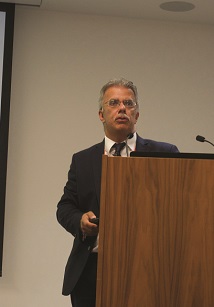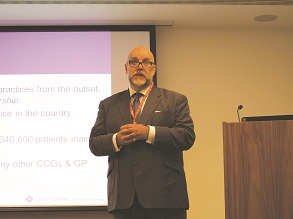A new dawn
Last month there was uproar as online GP provider Babylon Health started offering its services to patients in London. GP leaders warned that the provider would cherry-pick younger, less costly patients, leaving traditional general practices with older, frailer patients with chronic illnesses and comorbidities.
Babylon Health, which operates under a general medical services contract, offers patients the ability to book an appointment in seconds via an app and then have a video consultation with an NHS GP, typically within two hours of booking. If needed, a face-to-face appointment can be booked on the same day or the next day at clinics in central London, Monday to Saturday.
To use corporate lingo, this is disruptive technology – tech that tears up a long-held way of doing things by being more efficient, more effective and consumer driven. But NHS England had already begun updating general practice in response to rising demand and the need to cater for services coming out of hospital. Last year’s General practice forward view boasted that its plans would likely produce a triple revolution – modernising general practice as a career, as a business and as a way of delivering services to patients.
The GP forward view said NHS England would work across five areas – investment, workforce, workload, infrastructure and care redesign. The latter includes the new models of care vanguards, particularly multispecialty community providers (MCPs), although primary and acute care systems (PACS) are also creating vertical integration between primary and secondary care (see box).
Speaking at last month’s HFMA Commissioning Faculty conference on the future of general practice, Arvind Madan (pictured), NHS England’s director of primary care and deputy medical director, said the forward view committed NHS England to increasing spending. Speaking before the Budget, he said this would rise from £9.6bn in 2015/16 to £12bn in 2020/21, a 14% real-terms rise when the rest of the NHS gets 8% more.
More than £27m has been spent on practice resilience so far, which provides support for 2,100 practices, with a similar amount to come over the next three years.
NHS England is funding GP clinical insurance this winter and the Department of Health is seeking to set up a state-backed indemnity scheme. It has also pledged to fully reimburse the costs of Care Quality Commission inspections.
Staff exodus
Some surveys have shown that a third of GPs are looking to leave the profession in the next five years, including two-thirds of all family doctors aged over 50. The NHS clearly needs the additional 5,000 whole-time equivalent GPs by 2020/21 promised by the forward view. This number includes specialists working in general practice and GPs in training.
Outside of this, NHS England is working to develop the wider primary care workforce, adding numbers of other clinicians such as nurses, pharmacists and physician associates, as well as developing the role and training of practice managers.
Working in multidisciplinary teams led by GPs could reduce GP workload and benefit patients, Dr Madan said. For example, sending patients with musculoskeletal disorders to physiotherapists as their first contact could mean that most cases are closed without needing to see a GP.
He added that about 16 million contacts with GPs each year were of low value. ‘Many of these could have been tidied up in hospital – where they were sent home without medication or where a fit note wasn’t issued, for example.’
NHS England is also working with the General Medical Council and the CQC to reduce the demands for data on practices.
More than 750 schemes have been completed under the forward view estates and technology fund, with 200 being delivered and more than 600 in the pipeline. NHS England is also offering financial support for stamp duty land tax and reimbursement of VAT.
Undoubtedly, technology will play a central role in the transformation of general practice – through online consultations, for example, for which NHS England has earmarked £45m, with £15m allocated this year.
Online services offered by Babylon in London have caused some concern, with clinical commissioning groups and GPs worried that this service will attract younger, tech-savvy and less ill patients – the types of patient who rarely see a doctor but who, because GPs are paid largely on a capitation basis, are vitally important to the financial viability of practices.
The Carr-Hill formula used to allocate funding to practices does not account for the emergence of digital providers. Many senior GPs argue that it will have to be rethought but any changes must ensure the digital care and practice-based care can develop and complement each other.
Evolving picture
Even before the GP forward view, general practices have been reorganising, often in response to demand pressures and lack of doctors in secondary care. They have aimed to provide enhanced services, such as asthma or diabetes care, as well as bread and butter general practice – patients with coughs, low-level mental health issues or those who require referral to specialists.
Dr Madan said GPs were beginning to work together across a number of different options, from loose natural groupings covering 30,000 to 50,000 patients, through to more formal arrangements that will perhaps develop into MCPs or accountable care organisations.
Looser arrangements are usually called alliances or federations. Those that have merged – with all practice income pooled – are often referred to as super practices, though terminology can differ across the country. A super practice doesn’t necessarily have to be large – it could have a relatively small number of GPs under a single management board.
Lakeside Healthcare is a large super practice, and one of the best known, with more than 200,000 patients covering a swathe of the East of England. It is hugely ambitious, with chief executive Robert Harris aiming for a list size of one million by 2020.
‘We are at a tipping point and real change has to come from the provider side in primary and secondary care,’ he says. ‘We are in denial about a lot of things. Every day contracts are being handed back and citizens are being disenfranchised. Not enough resources are going back into the system and at the same time demand is going through the roof.’
He points to analysis of hospital activity and costs, including admissions, outpatient consultations and A&E attendances, which divided patients into three groups – the sickest and most vulnerable (5% of patients); those with a single chronic disease or at risk of a major procedure (20%); and those who are generally healthy (75%).
‘We have about 5% of our patients who account for about half of our costs and this analysis applies nationally, regionally and locally. The next 20% of people, if not managed properly, could account for up to 40% of costs.’
Three years ago the practice became a vanguard MCP and, like others, has redesigned and expanded the care provided by primary care clinicians. Professor Harris (pictured) says it looked at what capitated budgets might mean for its risk management, the broader workforce and the areas of specialisation it could offer. It realised that a bigger practice is more resilient – attracting more income – and allows GPs to specialise should they wish. ‘You can’t possibly do that in a small practice and it makes us a more attractive place to work,’ he adds.
On joining the practice, GPs dissolve their former practice and become equal partners in Lakeside. In return, GPs have to give up the autonomy they enjoyed previously, Professor Harris says. ‘That’s the only debit. Everything else is a benefit – we do the clinical governance, the corporate work, we have a single IT system, we do the financial management and HR. We do it once and we do it centrally.’
Often, there is no single reason for practices to come together, but they can range from the benefits of population health and developing GP specialisms, to clinical and financial sustainability.
Cornish merger
In St Austell in Cornwall, the prompt for a merger was the failure of the largest GP practice in the town in 2014. The three other local practices rallied round and merged a year later to form St Austell Healthcare. The decision was driven by issues such as concern over recruitment and retention, the need for cost savings, service redesign and innovation.
Bridget Sampson, St Austell Healthcare’s managing partner, says the practice is working towards an MCP contract model. It has separated planned and acute care onto different sites, with a central acute hub open 8am to 8pm on weekdays. Access is based on telephone triage and a multidisciplinary team, including doctors, nurses and pharmacists, delivers care.
‘The benefits of doing things at scale mean we have created teams – a back-office team, a secretarial team, a QOF team and a prescribing team, for example – which gives us career progression. That is something you don’t often see in general practice. We can also develop services, and offer some that are usually seen in secondary care.’
A consultant comes from the acute hospital to offer ophthalmology services, including glaucoma monitoring, for example, while GPs are leading multidisciplinary teams covering chronic illnesses such as asthma and diabetes.
Funding for new services at practice level is often tied up in existing contracts and commissioners are working to disentangle funds for services that can be offered in primary care.
York approach
Vale of York Clinical Commissioning Group has developed a gain share arrangement for primary care dermatology. Local hospital dermatology was facing a number of pressures, including staff shortages that had an impact on the 18-week waiting time, and a surge in urgent referrals (a 30% increase in two week waits). At the same time, GPs were performing less minor surgery.
Under the CCG scheme, GPs are encouraged to use dermatoscopes to photograph dermatological problems and send it for review. This allows specialists to identify cases that can be successfully managed in primary care. The scheme saved £121,000 in 2016/17, with practices receiving a total of £38,000 under the gain share agreement for investment in primary care dermatology services.
Professor Harris says the Lakeland practice realises success lies in its ability to unlock existing funds. ‘Ideally, we will do so working with a hospital on some kind of gain share and working with commissioners to redesign services,’ he says. ‘When the MCP started we didn’t say: “Give us more money”. What we wanted was the licence to design and deliver new care models.’
This has manifested itself in a number of ways – supporting hospitals to shift surgery from overnight to day case; providing care in community facilities run by the practice; and allowing teams led by extensivists (GPs who specialise in the care of frail elderly patients) to spend more time with patients with the greatest needs and complexity. These patients may have two or more comorbidities, such as dementia, liver disease and COPD, together with risk factors such as obesity.
Segmentation of the practice population into risk categories has helped identify the degree of care patients need. Other patients with chronic illness – congestive heart failure or diabetes, for example – are cared for by enhanced primary care teams, while patients needing less complex surgery, including some ophthalmic, orthopaedic and dermatology procedures, can be operated on in its ambulatory surgery centres. Professor Harris says this provides commissioners with lower cost care through a smaller fixed cost base and economies of scale across the practice area. ‘The biggest potential blocker here is how you agree the gain share with the hospital and CCG,’ he adds. ‘We are seen to be a threat, rightly or wrongly, to hospitals. We could take away up to 60% of what they do currently. We believe there’s a different and viable alternative to what’s gone before, but it requires guts on the part of regulators and on the part of commissioners to decommission a service and recommission elsewhere. We should be agnostic about who is providing the service.’
General practice is the foundation of the NHS, but, like its secondary care counterparts, will need to modernise the 1948 blueprint. IT, including video consultation, will be part of this vision, as will more collaborative teamworking, but perhaps the biggest change will be ensuring GPs have more time to counsel and treat patients with the most complex needs.
Primary move
The Royal Wolverhampton NHS Trust is a provider of acute and community services and, increasingly, primary care.
Royal Wolverhampton’s PACS went live on 1 June 2016, with the trust taking on five practices and a population of about 23,000. It now works across 11 sites with a list size of about 60,000 and several other practices in due diligence.
The trust is approaching around a quarter of the practices in Wolverhampton under its ambit and has begun to expand into South Staffordshire.
All its GPs are salaried and the trust runs an integrated delivery model with primary, secondary and community services staff working closely together.
Sultan Mahmud, the trust’s director of integration, says it has already seen some benefits. ‘We’ve seen a seismic shift in primary care access, with 10,800 additional primary care appointments since June 2016, so patients have seen a very real difference in access. We have worked with established primary clinical systems providers like EMIS to be able to monitor the difference we are trying to make.’
In terms of system metrics, early data is encouraging. There has been a reduction in emergency department attendances of around 1%, which Mr Mahmud says is modest but encouraging.
‘In terms of emergency admissions, we have seen a reduction of 10% and also a reduction in emergency readmissions by 8%.
‘These are encouraging signs, but our clinicians and informatics team are drilling down into patient-level data to understand how further improvements can be made. Wolverhampton CCG has worked hard with all GP groupings and the trust to reduce demand.’
Explaining these figures, he says: ‘Causality is difficult to pin down, it’s not that straightforward. But once you start to integrate primary and secondary care clinicians you can make a difference to healthcare delivery because incentives are aligned. There are opportunities to scale up and streamline processes – to reduce the admin burden, for example,’ he says.
While much of the local focus has been on bread and butter general practice, the vertical integration programme is also looking to develop GPs’ role to take care out of hospital, but with adequate resources and the infrastructure to manage risk.
Primary and secondary clinicians are working on a number of workstreams to manage more complex patients, discussing patient pathways and working out where GPs with a special interest or consultant outreach is the best option for patients.
The trust is actively working with local partners across the Black Country to develop an accountable care system. ‘We have decided that as a trust our future lies in being a driving force in population health management and supporting clinicians to move care to the most effective setting, cutting down on unnecessary bureaucracy and using our leadership and change management track record to benefit the wider system.
Related content
We are excited to bring you a fun packed Eastern Branch Conference in 2025 over three days.
This event is for those that will benefit from an overview of costing in the NHS or those new to costing and will cover why we cost and the processes.